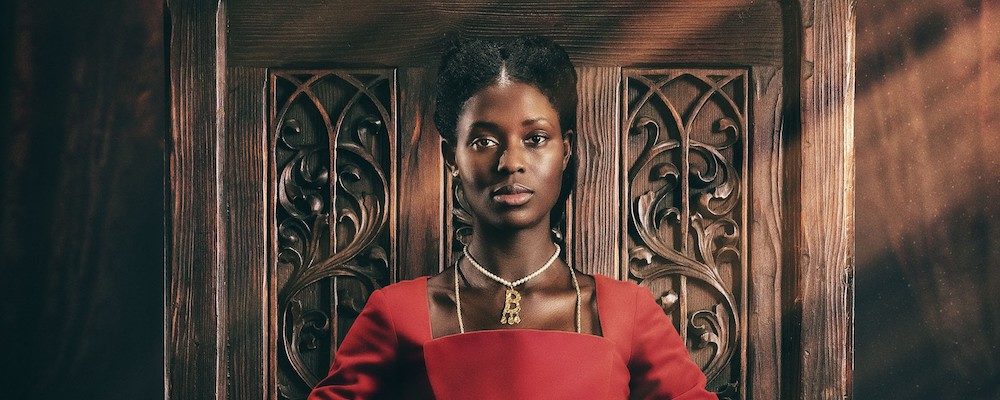‘Anne Boleyn’: A Good Concept Loses Its Head
Tony Sokol
AMC+’s “Anne Boleyn” is based on the “truth and lies,” which become facts in history. The three-part miniseries boasts about it in its opening explanatory disclaimer. It is a reimagining of the final five months of Queen Anne Boleyn’s (Jodie Turner-Smith) life from her own perspective. She sees herself as a futurist, one whose daughter may become the greatest monarch England will know, and who comports herself as an equal among men. You can’t do that when you’re married to the guy who would go on to invent the divine rights of kings, and declare himself the head of a church of his own construction.
“Your influence lies in your belly,” the Queen is told many times during the proceedings, “not in your mind,” and director Lynsey Miller makes sure every instinct Anne believes is wrong. The Queen of England is smart enough to know she can’t trust anyone, but is on a fool’s journey. She is not alone in this. Even her most avid nemesis, Thomas Cromwell (Barry Ward), who thinks he can outsmart a king, will go on to lose his head, but here he is the darkest specter. King Henry VIII (Mark Stanley) doesn’t come across as anywhere near the villain the smirking Cromwell does, but that’s only because we see a lot of the king after a hunting accident. His legs are ripped and bleeding, and the concern Anne shows over him bestows much more sympathy than his character warrants. This, is of course, the point, because in the court of kings, everything is a turnaround.
When the drama unfolds, Boleyn, has been queen for two and half years, given birth to one daughter, Elizabeth, and has had two miscarriages. She is pregnant with the Tudor King Regent. Boleyn is competing for the king’s affection with the much younger Jane Seymour (Lola Petticrew). Who she’s competing with is almost incalculable. “I know what it’s like to have all eyes on you, yet never truly seen,” Anne warns the young Jane, who is all about security and stability, neither of which is to be found in a king’s bed.
Stanley’s Henry is all lust, self-interest, and Teflon-coated excuses, anachronistic as that may be for 1536 Great Britain. Henry is a bit like former President Trump in that way. He’s got a castle full of closeted skeletons, and every crime he himself is guilty of, he chops off someone else’s head over. Anne is accused of questionable morals, and even crimes against nature, just so her husband can try them on for himself. “It is difficult to love a man, especially when he is your husband,” Boleyn reasons.
Historical sources say Anne Boleyn had dark olive skin, but she has been played by Vanessa Redgrave, in “A Man for All Seasons,” Helena Bonham Carter in “Henry VIII,” Natalie Portman in “The Other Boleyn Girl,” Natalie Dormer in “The Tudors,” Geneviève Bujold in “Anne of the Thousand Days,” and Claire Foy in “Wolf Hall.” Each of the players brought a bleached regal standing to the role, but underneath you knew they could throw a royal fit.
Turner-Smith is the first Black woman to play Anne Boleyn. She plays it with such restraint she almost becomes one of the still-life portraits hanging in the gallery, albeit one with not quite a stiff upper lip as much as a wooden one. Although it occasionally quivers, her emotions are felt deepest in the reflections of those around her. Seeing Anne and her brother George Boleyn (Paapa Essiedu) as the only dark-complected pawns counseling to an all-white board makes the chess match metaphor more glaring than necessary. This is especially true when they are accused of incestuous adultery, further isolating them from recognizable royalty, the body politic and all but the most impolite society. When Anne is taken to the tower and scrutinized beyond all privacy, it is nakedly dehumanizing. Boleyn comes across as the grounded realist, but is ultimately the most delusional character. Too bad “Anne Boleyn” is not a psychological thriller.
It is also not a historical drama. We don’t learn anything new in “Anne Boleyn,” except Princess Mary (Aoife Hinds) was “a spiteful little bitch,” according to Anne. All of the historical intrigue is pushed off into the corners, away from the central figure. Henry was a reformer who broke from the church to dissolve his marriage to Catherine of Aragon in order to marry Boleyn, only to behead her after three years of marriage. Boleyn was 35. Her legacy was saving her daughter by martyring herself and her birthright. When she was beheaded, Anne Boleyn made a last statement from the gallows. Turner-Smith never gets to explore the mental deterioration of the role, and is denied the final, curtain-closing soliloquy.
The screenplay is unimaginative and unenthusiastic, filled with revisionist inaccuracies, anachronistic dialogue and a soapy froth. The acting is wooden, mannered, and most of the recognizable cast becomes wallpaper against the ornate settings, and detailed costumes. The first episode comes at us with promise, which gets deflated too soon. The last is a bland historical anticlimax.
“Anne Boleyn” takes itself a little too seriously, but doesn’t do the serious work. Henry the Eighth is a buffoon led around by his dick, rather than the monster with a tower of tortures at his command. Anne Boleyn is bound as tightly to one dimension as she is in the restraining bodices of pre-Elizabethan fashion. We get glimpses of ominous promise, and lingering morbidity, but in the end, the camera pulls away before history spills out under the extremely friendly executioner’s blade.
“Anne Boleyn” premieres Dec. 9 on AMC+ with new episodes streaming on Thursdays.

